I’ve written about the science behind acquired taste and cybernetic eyes. I planned to touch on the other senses. (Pun intended!) What better time to investigate the science behind touch, since two scientists have won a Nobel Prize for the discovery of touch receptors. Using seemingly random items; chili peppers and pipettes!


THE SCIENCE BEHIND TOUCH
Which sense do you think people most take for granted?
Touch received ZERO votes.
My tweets here"In science many times it's things we take for granted that are of high interest." --Ardem Patapoutian

I bet you a pizza that Dr. Patapoutian (one of the Nobel prize winners) would have voted for the sense of touch!
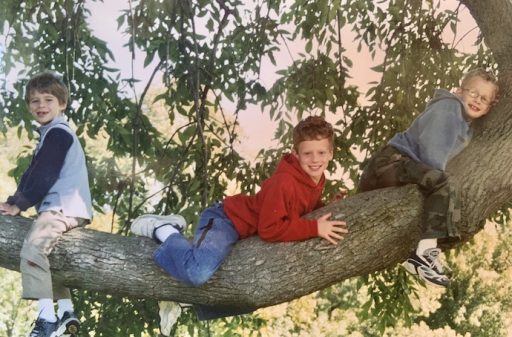
HOW DOES TOUCH WORK?
There will be no neuron quiz today.
THERE WILL BE A QUICK TOUCH OF SCIENCE ALA REVIEW OF THE NERVOUS SYSTEM...I promise it's speedy quick! (yes, another pun)
Since we're talking about touch, in this post we're referring to specifically sensory neurons.
Sensory neurons carry information FROM the sensory receptor cells throughout the body TO the brain.
A FEW TOUCH RECEPTORS TO INCLUDE HEAT, COLD, PAIN, PRESSURE, PROPRIOCEPTION (where we are in space!)
The big deal was that scientists didn’t know where the receptors that stimulated the sensory neurons were located, not exactly. ‘In our skin’ doesn’t cut it. Unless we get a cut. (There won’t be blood in this post either.)
Here’s some of what we did know before the discovery of the touch receptors!
SOME HISTORY OF THE SCIENCE BEHIND TOUCH
The concept that the nervous system was a system, was so important that they– not sure who ‘they’ are–named an organelle (part of a cell) after Camillo Golgi.
Okay, Golgi discovered Golgi bodies but still. Golgi & Cajal aren’t exactly household names yet they did important work.
A post about nerves and the science of touch wouldn’t be complete without touching on pain. (pun # 3 for the win) And if you’re interested in the intrigue of poisons, which also cause pain, click here.
THE SCIENCE BEHIND TOUCH : PAIN
A-delta and C-fibers
The A-delta fibers send the “first pain” into the brain.
C-fibers travel more slowly, so you notice the pain from C-fibers several seconds following an injury.
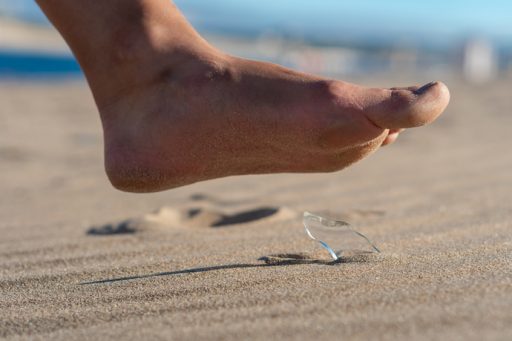
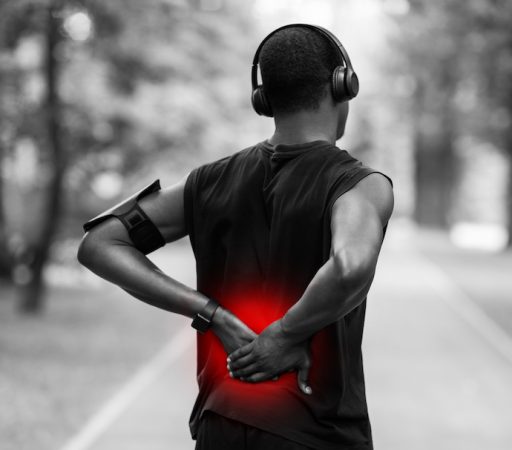
THE SCIENCE BEHIND TOUCH : PROPRIOCEPTION
Here’s another example of something we take for granted. Proprioception.
The sense that lets us perceive the location, movement, and action of parts of the body is proprioception or kinesthesia.
A-alpha fibers are the proprioceptive fibers and easily the fastest. Why?
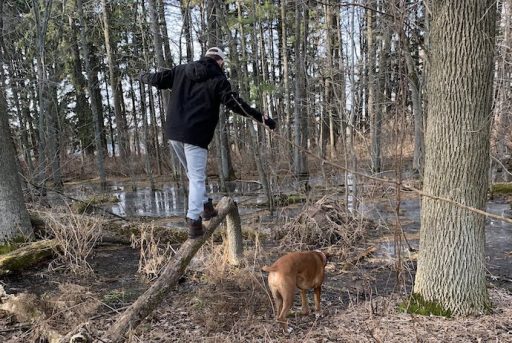
We have to know where our limbs are in space at any given time!
Now that we’re up to A-alpha myelination knowledge speeds, let’s get to the newest discovery!
HOW DOES TOUCH WORK?
These two scientists won the 2021 Nobel Prize for Physiology or Medicine for answering the million dollar question:
How are temperature and mechanical stimuli converted into electrical impulses in the nervous system?
(It doesn’t sound as exciting when I type ‘physiology or medicine’ as if they aren’t important enough to have their own category!)
HOW DOES TOUCH WORK...ION CHANNELS
THESE NEWLY DISCOVERED RECEPTORS RESPOND TO HOT & COLD!
NOW THAT YOU KNOW ALL ABOUT THE SCIENCE OF TOUCH, WHY DOES THIS MATTER?
The groundbreaking discoveries of the TRPV1, TRPM8, and Piezo channels by this year’s Nobel Prize laureates have allowed us to understand how heat, cold and mechanical force can initiate the nerve impulses that allow us to perceive and adapt to the world around us.
Nobel Committee press release Tweet
MORE TOUCH RECEPTORS ARE POPPING UP!
PIEZO PROTEIN ION CHANNEL APPLICATIONS
Remember that silencing the Piezo gene renders the cells insensitive to poking with a micropipette! In theory, silencing touch / proprioception could help with issues such as mechanical (joint) pain, respiration, blood pressure, and skeletal remodeling.
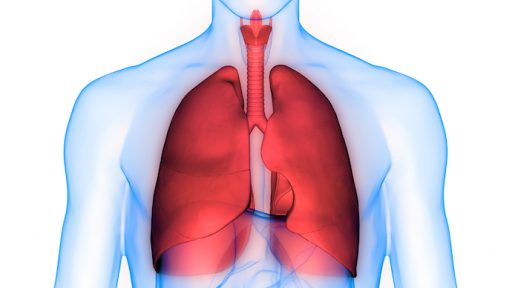
TPV1 PROTEIN CHANNEL APPLICATIONS
And the TPV1 channel could be closed, thus decreasing issues such as inflammatory pain, lower core body temperature due to high fevers, dampen protective reflexes or aid with neuropathies and visceral pain.
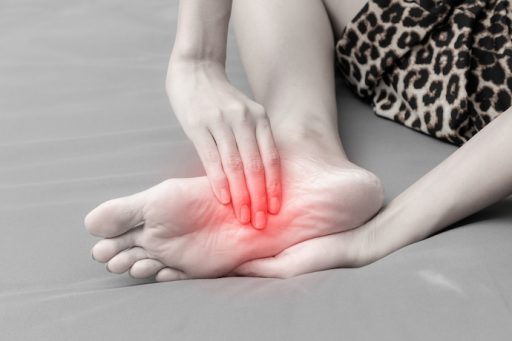
PERIPHERAL NEUROPATHY AND DIABETES
How about peripheral neuropathy and diabetes! It would be cool to do the opposite & stimulate the TPV1 channels, so people w/o sensation would notice if they stepped on a thumbtack or cut themselves. They could take care of their injuries instead of getting infections.
Patapoutian & Julius’ discoveries could lead to the development of non-opioid painkillers and treatments for “a wide range of disease conditions, including chronic pain.”
THE SCIENCE BEHIND TOUCH
Let’s give it up for these scientists. They identified critical missing links towards understanding how our bodies respond to the world around us.
And when they use their Nobel prize money–an equal split of $1.1 million–to host a pizza party for their lab staff, you can be sure everyone knows the mechanism when they burn their hard palates!
What do you think about the science of touch & these amazing discoveries? Imho, scientists should be paid as much as athletes!


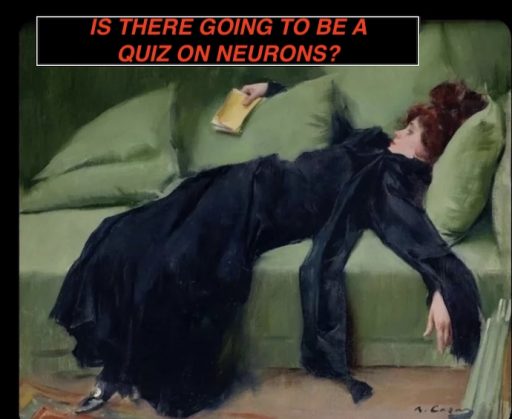
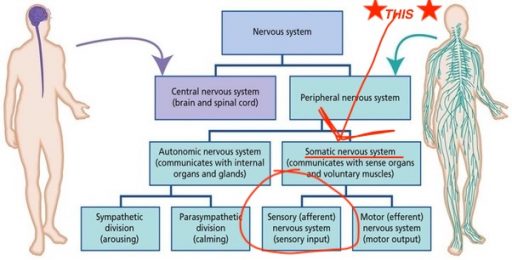
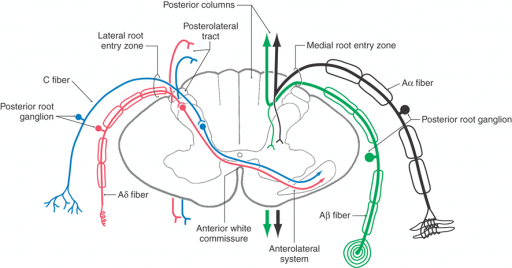


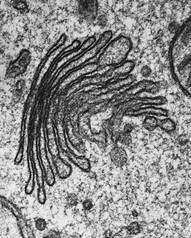
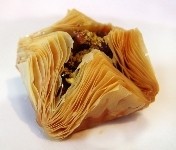

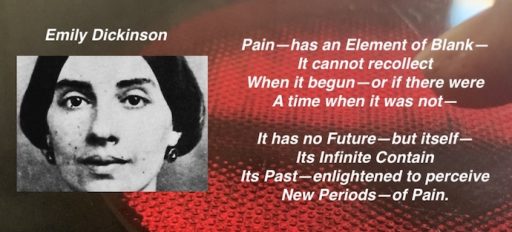
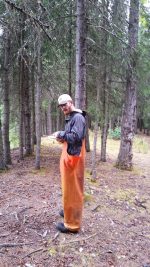
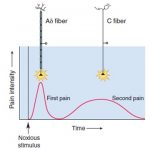

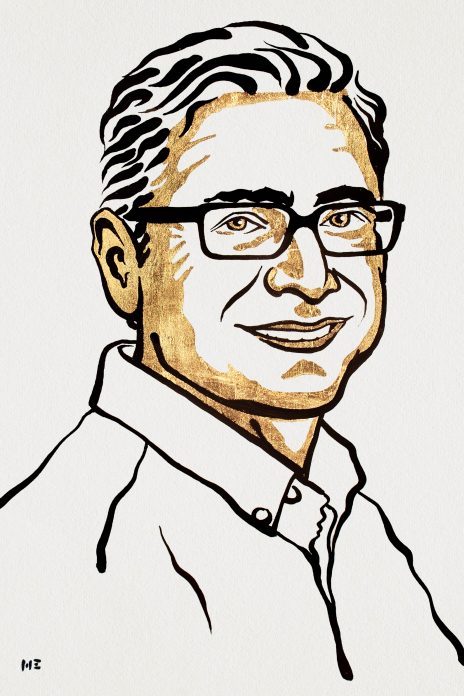
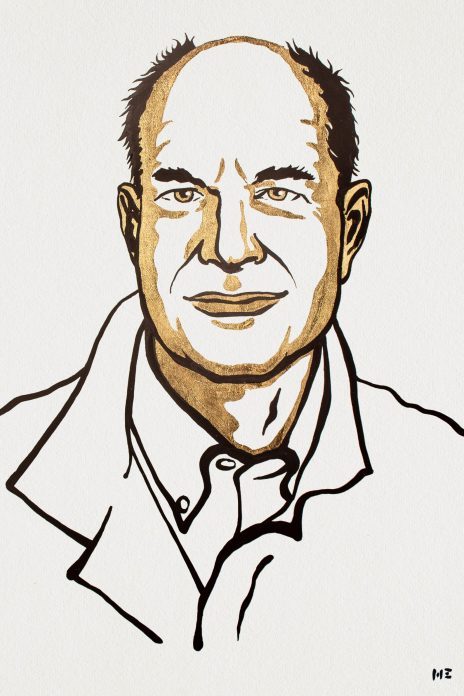

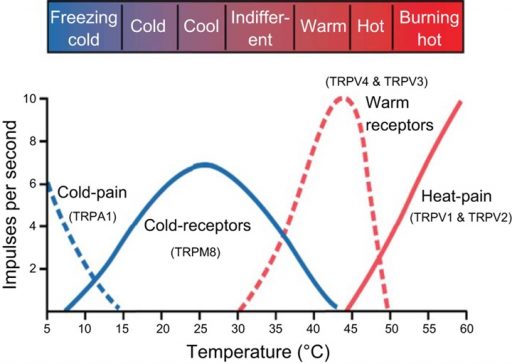

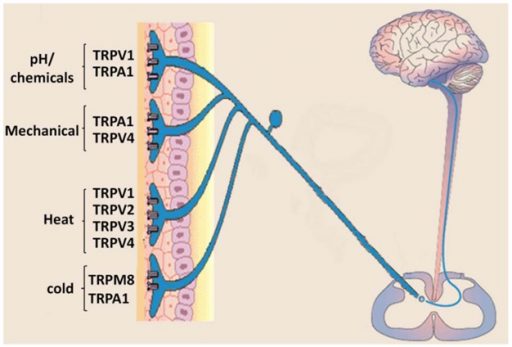





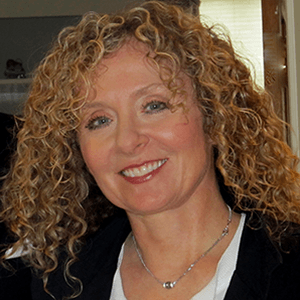
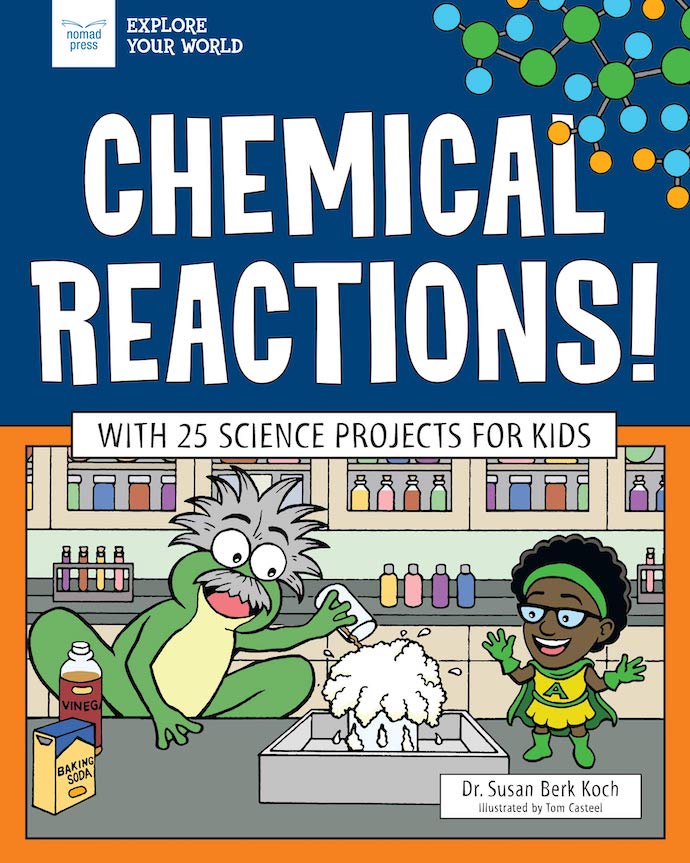
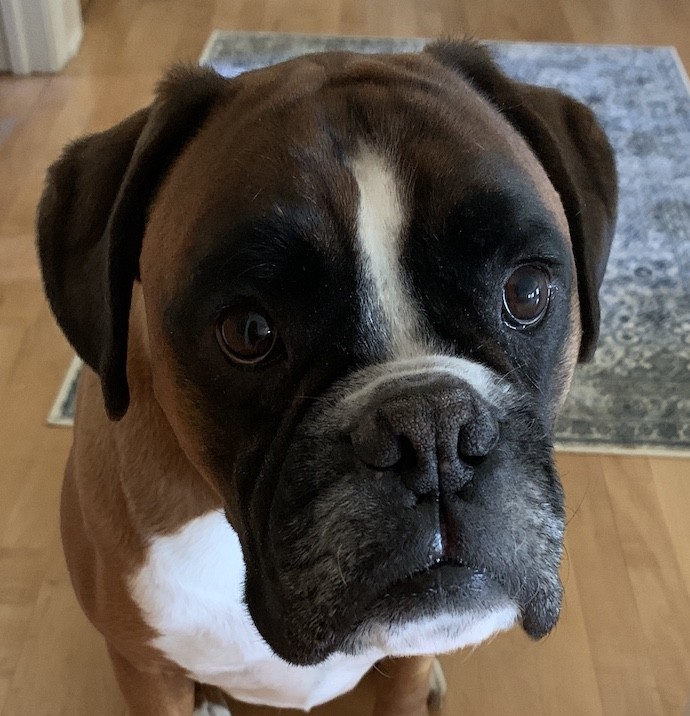
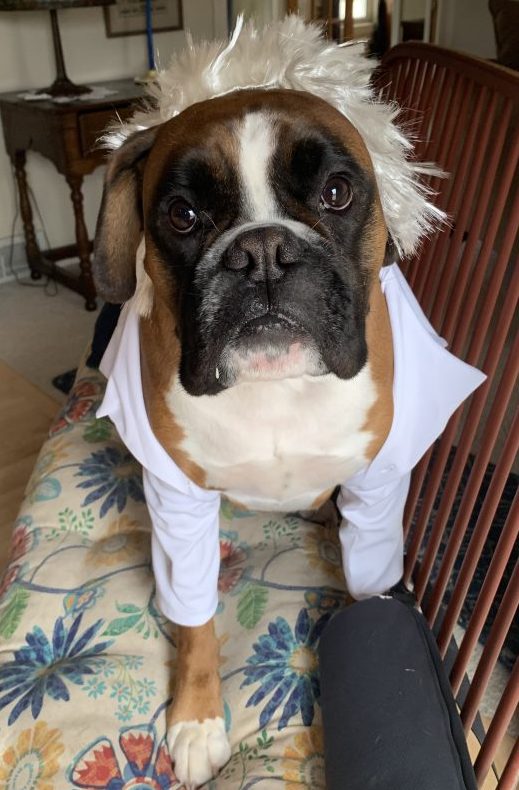
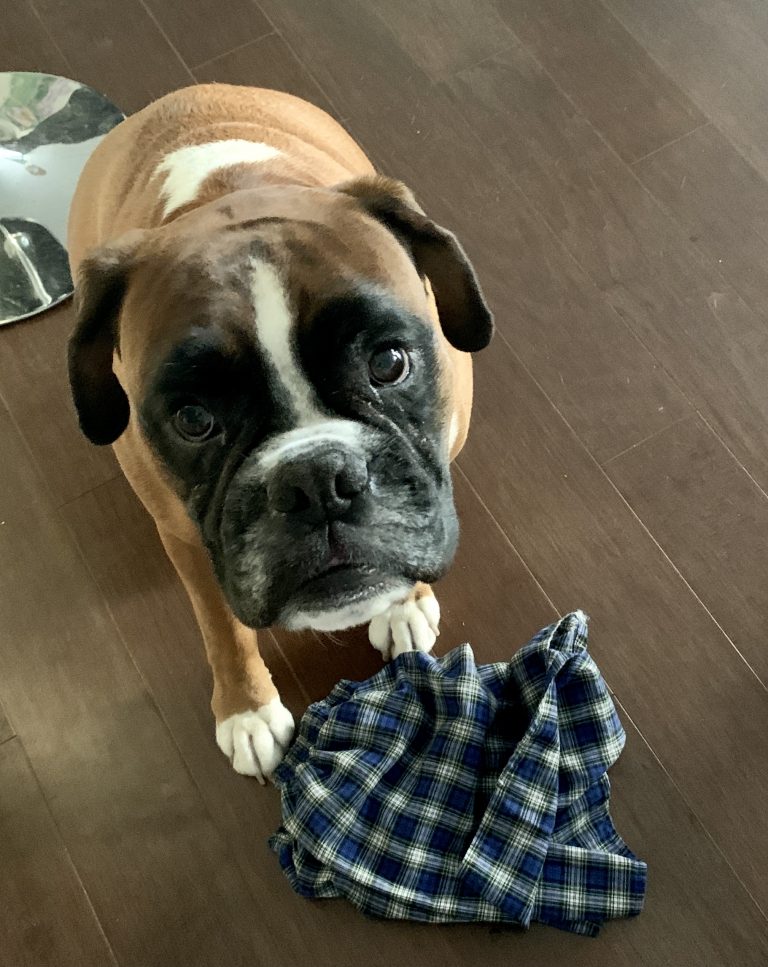
I always though touch, pain, and temperature perception were three different sensory systems, I didn’t know they were connected like this. How about wetness perception?
Great question. Our skin doesn’t have wetness receptors so the pathway is more complex. Researchers -so far- have found that A-fibers are involved and that wetness perception increases with lower temp water. We need to be more careful with hotter water. Thanks so much!
What an interesting article.
I love hearing about new topics and learning something different.
The format is also great and love the quotes and images. Maybe not the broken glass one. Ouch.
So informative. I feel like I’ve learnt something new for today 👍
Agreed, the broken glass photo makes me wince, too. I’m happy you took a few facts away from my post. I appreciate the kind words, thanks so much!
This is a LOT of information that feels over my head. I’m always so impressed by the thoroughness of information you put together. After reading through it all I definitely think I’ve been taking the sense of touch for granted!
I’ve been taking the sense of touch for granted, too! I put some of the more dense info in slides, which –in my wee brain– makes it more accessible. Or more easily skipped! ha! Thank you for stopping by!
Wow, this is so interesting! The human body is an amazing, complex machine. I love your slide shows and all the great pics, especially of Louie. Thanks for enlightening me.
I’m so pleased that you found my post intriguing! The science gets a little dense, but that’s what makes these discoveries all more amazing. Louie and I thank you!
Wow! What an amazing blog! I love the little slideshows. It breaks the reading up nicely! You are a great writer! I’ve learned a lot about the science of touch! X
Thank you for the kind words, Ruth! I love the slide shows, too. I appreciate you stopping by!
Being able to locate the touch receptors is fascinating — all these things we experience, sense and respond to without even thinking about it is incredible. Thanks for the info — I feel like I understand how/why I’m so tactile!
How cool that you’re so attuned to your sense of touch. I agree, the autonomic nervous system is amazing. Thanks!
The research and time that you put into each and every one of your blog posts always leaves me in awe! I am quite a touchy feely person with the people I love. When I’m unwell, the touch of my husband instantly makes me feel better – even just having him near me is like instant pain relief. It may a placebo for me but if it works, it works!
Rosie
That your husband can comfort you is not a placebo! It’s a complex science, incorporating neural pathways, repetition, and positive reinforcement ala endorphins. Your brain is actually wiring itself for pain relief ala your cozy spouse! I’m happy that you have him. Thanks so much.
What amazing systems/bodies we all walk around with and never realize it. And since there was no neuron test, I’m quite sure now I would have aced it 😉 Thanks for your hard work on these posts!
I’m sure you would have aced the neuron quiz, too! It is amazing that we walk around while our bodies are silently working away! Lionel Messi may disagree, but science is far more fascinating than soccer. Thanks, Eileen!
Honestly I’m always in awe of how incredible our bodies are and how we really need to appreciate them more!
I agree! Thanks so much, Amie!
I did not know all this about touch! This was super informative. Thanks so much for sharing all the info!
I’m happy that you found my post informative! Thanks so much!
Hi Sue,
Informative and great visuals as usual. I also appreciated the woman’s comment about how her husband’s touch can immediately make her feel better. Endorphins might be an interesting future topic.
I was thinking the same thing, Amy. Endorphins, the natural way to achieve pleasure.Like minds, thanks!
So much information here, it’s so interesting to read more about things that we just experience without even considering how our bodies work!
Corinne x
I agree. Touch is definitely taken for granted, making it more intriguing to find out the mechanisms behind it.Thank you!
The research and time you put into each of your posts is just amazing and I can’t thank you enough for it. I found this so interesting to read and learnt so much I didn’t know about the science behind touch. It’s incredible how the body works isn’t it? Xo
Elle – ellegracedeveson.com
I’m happy that you found my post interesting and informative! Fantastic, thank you!
Very interesting. Science is fun!
~Michelle
https://michellescrazybusylife.net
Science is fun! Thanks.
You have clearly done your research and there is so much information here that is so interesting to read. Thank you for sharing this article.
Lauren
I do love research. I’m gratified that you found my post interesting to read. Thanks, Lauren!
I will admit, things like this tend to go over my head, I don’t really understand this sort of stuff but it was an interesting read nonetheless! They definitely need to go into more understandable detail about this in schools!
I’m glad there was enough to entertain you in spite of the science! HA! I agree it would be great if schools would concentrate more on the sciences! Thanks so much, Jenny!
Fantastic post! I love that you’ve put a lot of research into this post, thank you for sharing x
I try to be thorough so I’m happy that you noticed. Thanks so much!
What an interesting educational post. Thank you for sharing.
Thank you for taking a look!
Very interesting post. I also enjoy the photos and slideshows (especially the Louie photos :). I’m very hopeful about new treatments for all of my chronic pains!
I love the Louie photos, too! Three cheers for curing chronic pain! Thanks.
Wow, that’s super interesting!
Thank you!
You did a fantastic job here Sue! So much information and so well presented. I always enjoy the fact you use humour in your posts and infographics. Thank you!
Eri, I’m gratified that you enjoy my humor! I’m glad that I’m not the only one. ha! I appreciate you stopping by. Thanks.
This post is so informative. As a nurse, I definitely know the impact of touch on showing care and empathy for others. I also know what if feels like to have altered sensation . I sustained nerve damage to my foot two years ago and still feel pins and needles. It’s important to be mindful of all of our senses.
I’m so sorry to hear about your nerve damage, Jodi. I hope over time you’ll regain more sensation in your foot! I’m happy my post resonated with you. Thanks so much.
The body is home to many different systems of nerves, bone, flesh, and muscle yet each one, in its own function, is as intricate and detailed as the next. The immense amount of design and function that goes into something as given as touch is amazing, and I love how you have broken it down in a fun and illustrated way. 🙂
I was going to break down another cool mechanism of the somatic nervous system and how it incorporates our skeletal muscles (The Withdrawl Reflex) but decided I’d gushed about sensory neurons enough! Another time. You’re right; our bodies are intricate, detailed, and intriguing. Thanks, Jaya!
This post is so interesting! I would definitely have chosen another sense in the poll, forgetting about touch. Which is funny because I have two chronic illnesses that come with chronic pain. I am very hopeful for future breakthroughs in helping chronic pain. Your posts are always so informative and I can see the amount of work that goes into them 🙂
I’m sorry to hear about your illnesses. I’m hoping for science to find better methods of helping people w/ chronic pain, too. Thanks for stopping by!
This was such an interesting and informative post. I always forget about touch as a sense.
Exactly! Touch is an under appreciated sense. I’m glad you thought my post was interesting & informative. Thanks!
What an informative post! Touch is definitely an under appreciated sense. It deserves more attention.
Touch does deserve more attention! Thanks so much!
Excellent explanation of pain. I wonder how many pain fibers Aaron Rodgers stimulated in packer land with his recent story about his so called immunization. What a pain in the blank blank blank blank! Great job as usual. Mike
I suspect Aaron Rodgers’ actions opened all the sensory ion channels because pain flooded everyone in packer land! ha!Thanks, Mike!
This was such an interesting read! I love how informative your posts are and I always learn something new. Thanks for sharing!
Thank you for the compliment! I’m happy that you liked my post!
Having read this I believed it was very informative. I appreciate you spending some time and energy to put this content together. I once again find myself personally spending way too much time both reading and commenting. But so what, it was still worth it!
I often think the same thing, that I spend too much time researching and putting the content together! Ha. I appreciate your time and thank you for commenting! It makes the effort worthwhile.